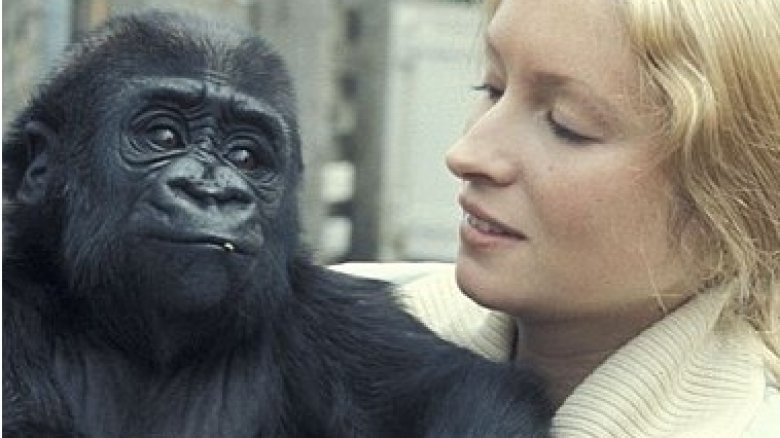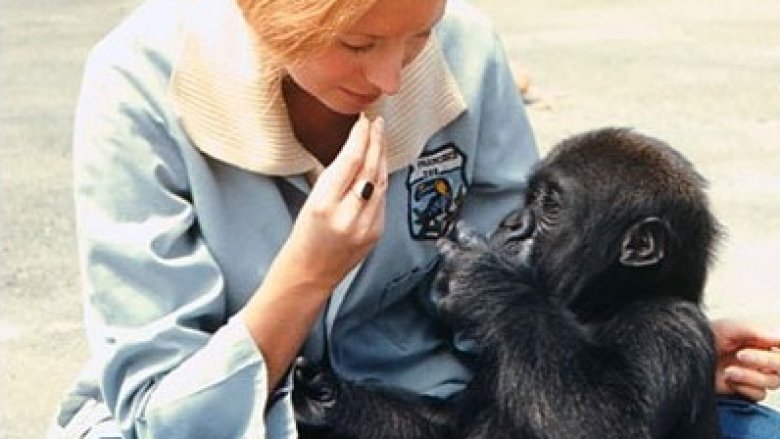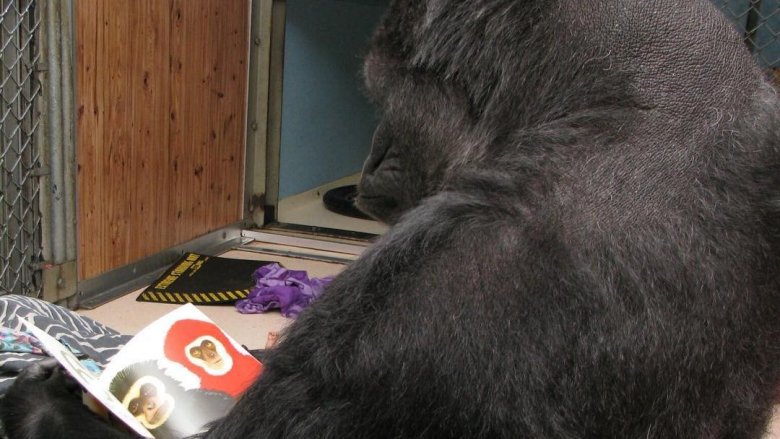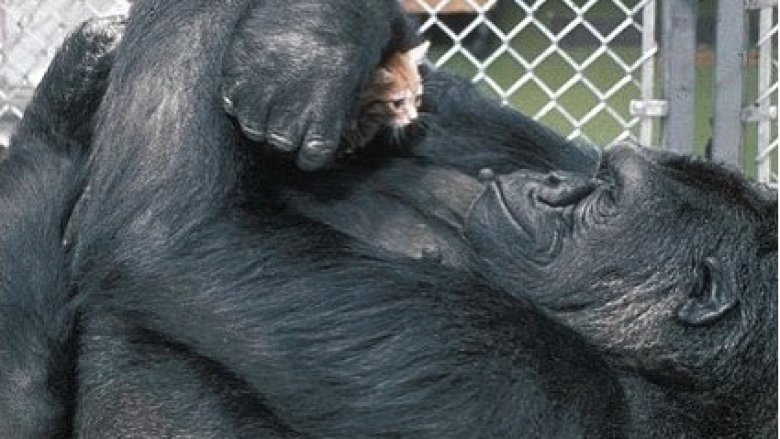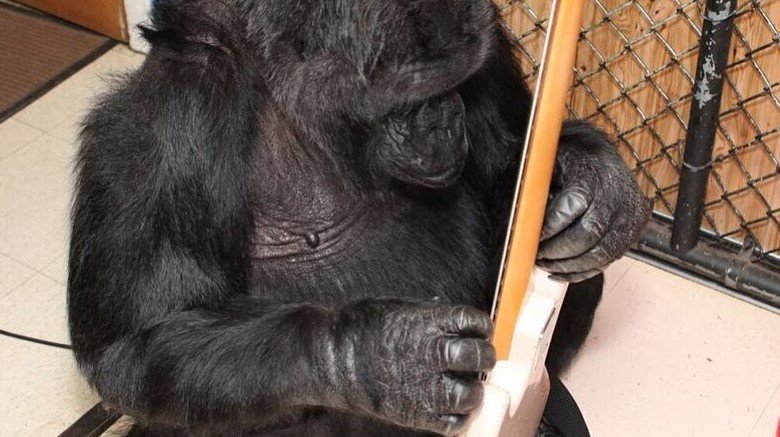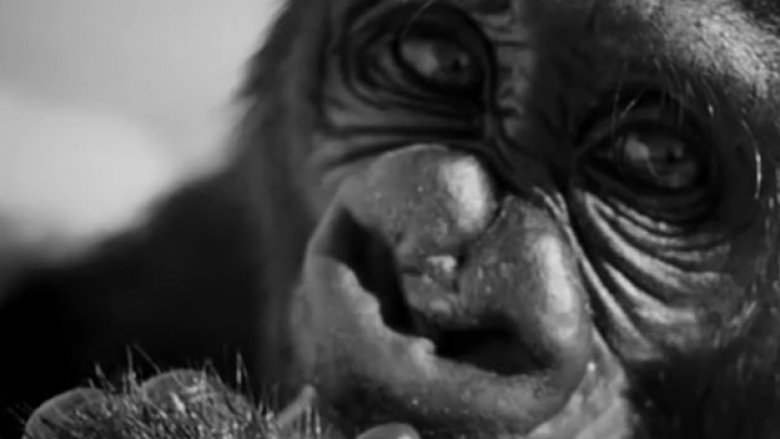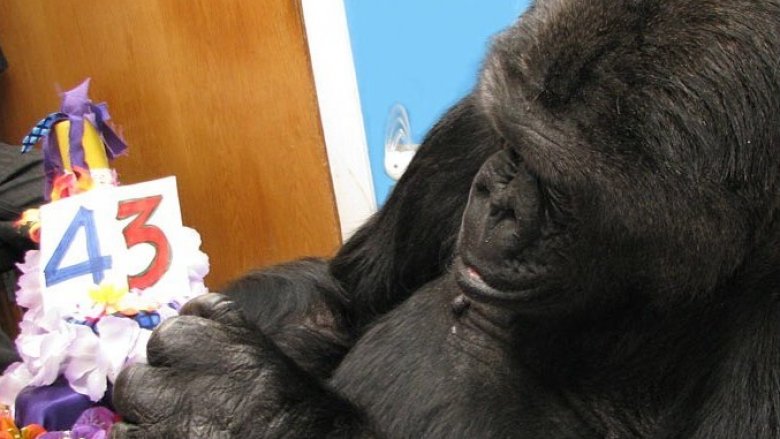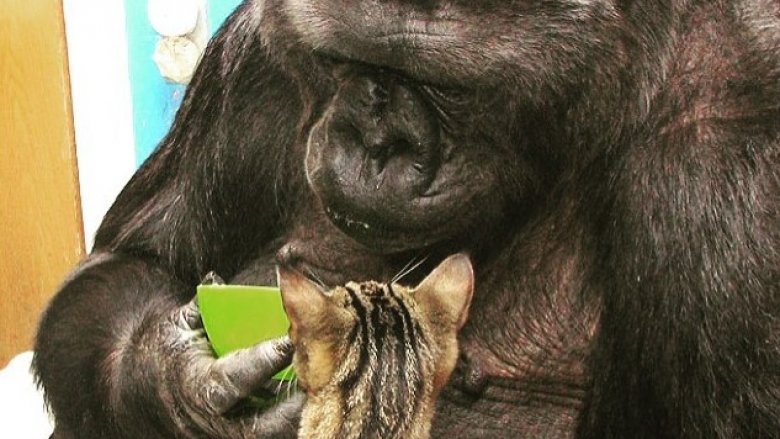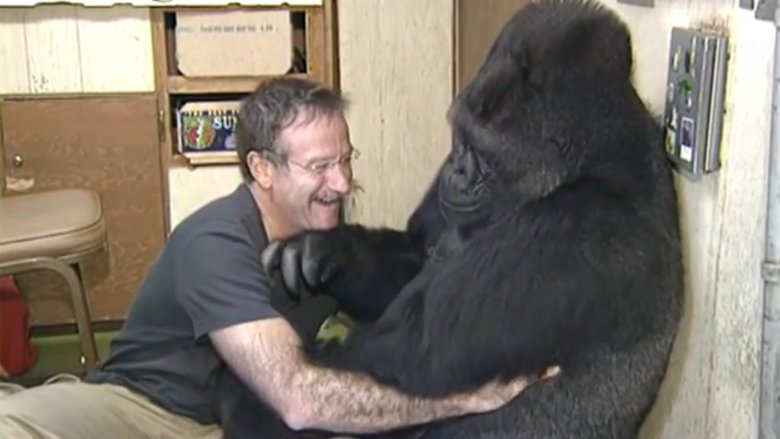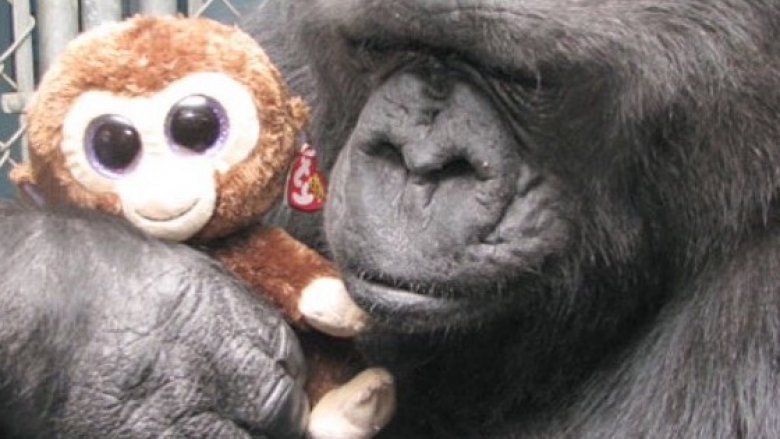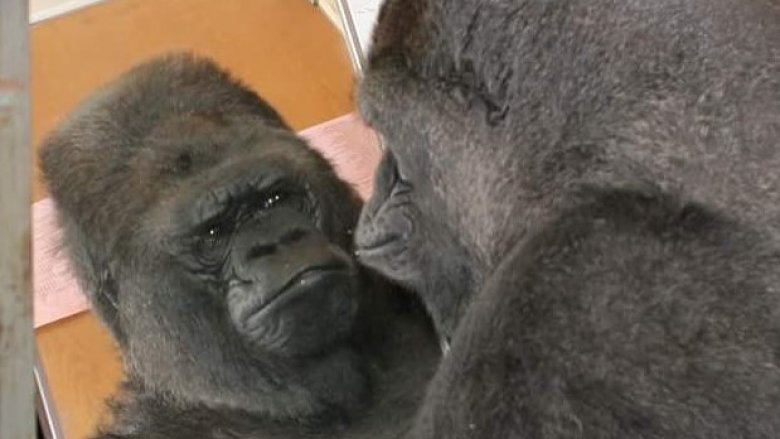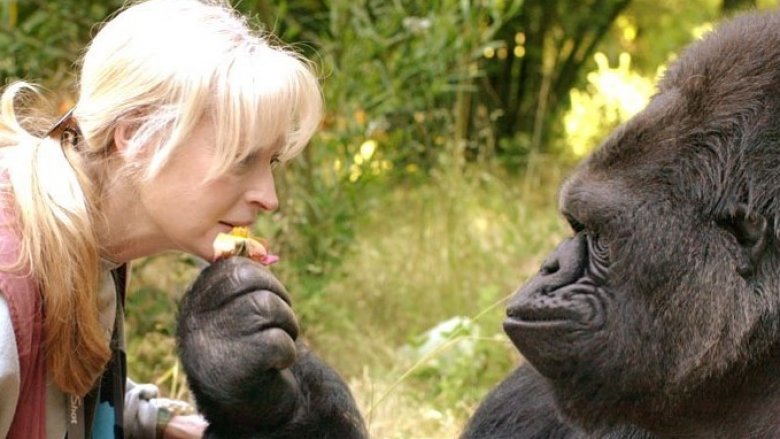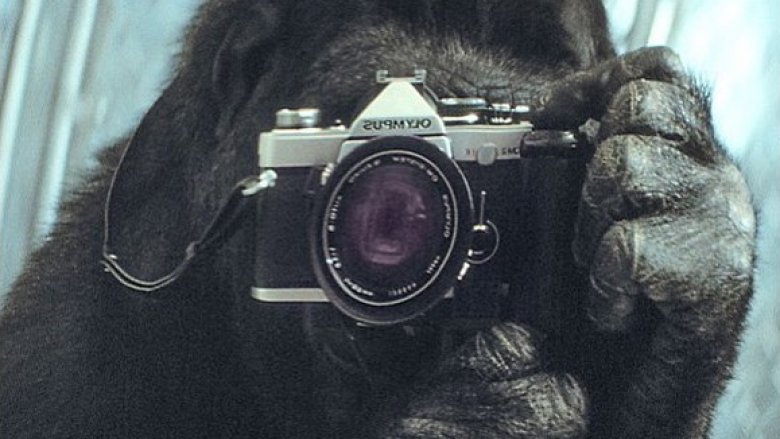The Untold Truth Of Koko
Not many animals are lucky enough to attain celebrity status outside their own homes, but Koko the western lowland gorilla absolutely did. Everyone knew her name (although it's formally Hanabiko, from the Japanese for "fireworks child"), and everyone knew her as the gorilla that learned to communicate with humans through sign language. That's an impressive skill for anyone to learn, and it was even more impressive considering she not only broke through the interspecies communication barrier, but let those who knew her best get a peek into her innermost thoughts and feelings.
Because gorillas — and all animals — do think and feel, and Koko proved as much. When she passed away in June 2018 at age 46, the world didn't just lose a gorilla, it lost an ambassador for an entire species. Koko was at the heart of The Gorilla Foundation, a nonprofit organization founded to research interspecies communication in hopes of fostering a worldwide attitude of conservation.
Koko learned a lot in 46 years, and she taught the world a lot, too. What don't you know about her? A lot.
She had a sad start to life
Koko was born in captivity, and her first months were spent on display in the nursery of the San Francisco Zoo. It was 1971, says The Gorilla Foundation, and those first months weren't easy. By the time she was six months old, she had grown deathly ill and was removed from public display. It was then that Stanford grad student Francine Patterson was assigned to give her the close care she needed, and Patterson immediately started teaching her and developed the idea of working with her to study psychology and communication.
Patterson spent the next 46 years working with Koko, and when she talked to The Atlantic in 2015, she remembered the first time she saw the little girl. "She was pretty spunky — very playful and curious, but she was also a bit insecure. She had a blanket that she carried with her whenever she went into new spaces."
Her ability to use symbols to communicate was innate, Patterson says, and within a few weeks of meeting her she had already learned the little gorilla's signs and taught her some new ones. Later, Patterson realized her skill only partially came from being born into a world where those around her spoke — other gorillas were using a sort of sign language of their own, she just needed to study them to figure out what they were saying.
Serious conversational skills
When CNN reported on her death, they also reported she had learned somewhere around 2,000 words and was more than capable of listening in on and following the conversations people had around her. While she typically used sign language to make contributions to those conversations, the BBC reported in 2015 on rumors she was learning to speak verbally. That wasn't the case — she was learning to make new sounds, and the media went a bit nuts with it — but the details of what she did learn were incredibly impressive.
Patterson said (via The Atlantic) Koko picked up on an incredibly apt sign she used to refer to herself: queen. They rarely used it, but she knew what it meant and she knew what people thought of her. Appropriate, right?
She also adapted some signs to suit her needs. National Geographic says she used signs for "bird" and "nut" when she needed to insult someone, and when she didn't know the exact sign for something, she'd get creative. The Gorilla Foundation says it took them some time to realize when, for example, she was signing the words for "stuck" and "metal," she was referring to a magnet.
Koko's kittens
The pictures of Koko with her kittens are among the most famous photos of her, but there's more to the story than just a few adorably candid shots. She seriously loved cats, an obsession that went back to some of her favorite picture books: Puss 'n' Boots and The Three Little Kittens.
In 1984, Koko asked researchers if she could have a kitten for Christmas. They gave her a realistic-looking stuffed cat, and she was not impressed. She refused it, signing repeatedly that she was sad — a completely legitimate reaction to getting a stuffed kitten in lieu of a real one. When her birthday came around in July, she was presented with a litter of kittens and told to pick one. She did, and she named the little orphan kitten All Ball.
Tragically, All Ball wandered off the grounds after only a few months, and was hit by a car and killed. Koko's mourning and tearful hooting made the LA Times, and researchers said she later signed, "Sleep. Cat."
While there wasn't a happy ending to that story, Popular Science did report that Koko got other kittens, including a pair for her 44th birthday: Ms. Gray and Ms. Black.
She had serious musical talent
Learning sign language is impressive, but less well-known is the fact that Koko (sort of) mastered something almost every elementary school child struggles with: playing the recorder.
It's a surprisingly big deal, too, and NPR took a look at just what a groundbreaking achievement this was. Before Koko's foray into music, scientists thought humans were the only species that could control their breathing to turn it into something more than an involuntary reflex. For a long time, it was argued that learning to control our breathing was one of the first steps our species took on the way to language. The fact that Koko could learn to do the same thing was radical, especially considering human children aren't born with that innate ability. They have to learn it, too, and that makes it just one more way we're more similar to gorillas than we thought.
Koko had a few other abilities that showed just how much she could control reflexes once thought to be involuntary. She could fake coughs and sneezes and blow raspberries, and she was even known to mimic a person talking on the phone. The BBC reported that was all misreported as sensationalistic news she was learning to talk, and that's a shame because it missed the point of what a big deal her actual abilities were.
Understanding the tragedy of human nature
No human parent wants to have those conversations with their children, the heavy ones about things like death, religion, and the point of life. Koko understood it all.
Patterson told The Atlantic that Koko was a unique opportunity to find out how gorillas viewed death. Gorillas had been previously seen burying dead animals, so they showed Koko a skeleton and asked her if it was alive or dead. She responded with "Dead, draped" ("draped" translated to something covered). When she was asked where dead things went, her response was poignant: "A comfortable hole." It was punctuated with a goodbye kiss, and Patterson also said (via Commonweal) that the idea was a peaceful one for her ... until she overheard Patterson talking about a drive that was going to kill her. It was abstract, sure, but Koko was terrified Patterson was in immediate danger, and wouldn't calm down until it was all explained to her.
That wasn't the only weighty conversation they had, and they also talked about God as creator and the meaning of life. Patterson says she was going on no sleep and was up against a newsletter deadline when she finally asked Koko what she thought the meaning of life really, truly was. The answer? Also poignant.
"People be polite. People have goodness."
She was counting down the days
Everyone has that friend, the one who counts down the days to their birthday, celebrates a whole birthday week (or worse, a birthday month), and keeps track of how many hours until it's Christmas. Koko did it, too.
Patterson told The Atlantic she was very, very aware of events that are actually only important because we assign them a symbolic value. She knew exactly when her birthday was approaching, and would start to draw pictures of cakes and birthday goodies. She recognized Valentine's Day cards as heralding the imminent arrival of still more goodies, and she loved fashioning new "clothes" for herself for Easter. Patterson says she loved dressing up for holidays, and suspected that she experienced time in much the same way people do. That said, she also experienced the full force of grief and mourning in a way that time didn't fix, either. Decades after All Ball's deaths, pictures of kittens that looked like her would still make her sign, "Sad. Cry."
Her best gorilla friend
In addition to her kittens, Koko had other friends, too. The Gorilla Foundation calls fellow gorilla Michael her very best friend, and while Koko shone in the spotlight, he was no less incredible. Orphaned at a young age, he was three when he was transferred into Koko's company and started learning sign language. The more fluent he got, the more stories he told — including an incredibly heartbreaking one about his mother.
When asked what happened to her, he signed, "Squash meat gorilla," then added, "Bad think-trouble, look face. Cut neck." The description came years after he was orphaned, and researchers think it's a first-hand account of his mother being slaughtered by poachers.
That's heavy stuff for anyone to deal with, let alone a baby gorilla. Michael died in 2000, long after it became clear his original purpose — being a mate for Koko — just wasn't going to happen. The Guardian investigated Patterson's quest to allow Koko to start a family, and when Koko was asked why she didn't accept Michael as a mate, she said it was because he was like her brother. She described the idea of mating with him as "embarrassing," which is hilarious and sad at the same time.
Koko finds a soulmate
Robin Williams was nothing short of a national treasure, and he met Koko in 2001. Any bad day can be made instantly better by just watching a clip of the two and their connection, and it was actually a friendship born out of grief.
Koko's friend, Michael, had passed away six months before her meeting with Robin Williams. In that time, Patterson said (via The Atlantic) she hadn't smiled, she had said much, she hadn't been eating. She was in mourning for her friend, and Patterson credited Williams and his visit for getting those first smiles out of a devastated soul. They laughed, he got her to play games for the first time since Michael's death, and Williams later had this to say about the meeting (via Today): "We shared something extraordinary: Laughter. ... It was awesome and unforgettable."
Years later, when Koko overheard the news that something was wrong, and when Patterson finally told her that Robin Williams had passed away, she mourned again.
Movies gave her nightmares
Gorillas are massive, powerful creatures, and it's impossible to come face-to-face with one and not be awestruck. But Koko — and friend Michael — showed an incredible sensitive side, too. Patterson told The Atlantic that Michael's childhood trauma of witnessing poachers murdering his mother left lifelong scars, and he was terrified of men working in and cutting trees. He regularly woke up from nightmares, screaming at whatever it was he saw when he slept.
It was Koko who had the vocabulary — and the desire to talk — that allowed her to share some of her nightmares, and some of them came from a surprising place: Jurassic Park. Patterson said that when the movie was coming out, there were images of dinosaurs everywhere. There were countless images and movie clips of them eating people, too, and after seeing a few of them Koko became terrified of her own toy dinosaurs. She poked and prodded them, pushing them as far away from her as she could get them. What she saw on television? It scared her.
She loved a British accent
Richard Stone has painted the portraits of people like Queen Elizabeth and Nelson Mandela, and he also painted Koko's portrait. He called it the most amazing encounter of his life, and he wasn't the only one awestruck by the sitting. Koko was enamoured of him, and he introduced her to something she hadn't experienced before: a British accent.
In 2016, The Telegraph reported that Koko's love of British accents had transferred to another, and that she had developed a massive crush on Benedict Cumberbatch. She repeatedly asked to watch his shows over and over, and when one group set out to make a documentary about her in the same year, her infatuation with Brits caused something of a problem.
The documentary director was Jonny Taylor, and according to The Guardian, Koko first inspected his nails, then his teeth, then asked him to take his shirt off. Patterson wasn't surprised, but it was a bit of a problem. She was a little too interested in him, and he was demoted to the second crew for being so darn attractive he kept distracting the gorilla from her camera time.
Of course there was controversy
Not everyone was convinced of Koko's abilities, though, and plenty of scientists called out Patterson's entire life's work at being more than a bit questionable. According to Slate, one of the biggest difficulties in verifying how much of any of this was actual, honest-to-gosh communication came because it was a huge, time-intensive process to raise, befriend, and teach animals that needed a lifetime of dedication. Sure, they're communicating, but are they using language? There's still a raging debate going on about that.
Patterson's relationship with Koko — and her fierce protectiveness — ended up making the controversy even worse, says IFLScience. Even though the close watch she kept over Koko was completely understandable, they say, it made it impossible for independent researchers to conduct any extensive studies of their own.
There's more controversy to pile on, too. Slate adds that the whole field of primate research is full of lawsuits, accusations, and weird relationships ... that sometimes end with more lawsuits. In 2005, two foundation employees who worked with Koko settled a lawsuit brought after they were fired for refusing to expose their chests to Koko in a way Patterson claimed would help them bond with her (via LiveScience). Controversial, indeed.
Why her memory matters
So why does any of this research — and Koko's abilities — matter to us?
National Geographic says her ability to use sign language was only part of what endeared her to the scientific community and the general population. Koko was proof that animals are capable of demonstrating an empathy and an emotional bond with creatures not just of their own species, but of other species. At the same time she showed the world how thin the line between human and gorilla was, and she was also a reminder of the unnatural lives some captive animals are made to live — an uncomfortable truth.
She also became a poster child for her entire, endangered species. She reminded people why we need to work to conserve not just gorillas but all the animals we share the planet with, and The Gorilla Foundation was able to make some important strides thanks to Patterson's work with Koko.
In 2001, they opened the Michael Sanctuary, a section of the Mefou National Park in Cameroon dedicated to caring for gorillas orphaned by poachers — just like Michael was. After Koko's death, the foundation announced they will be continuing with language research and conservation efforts, and that they "will continue to honor Koko's legacy."
